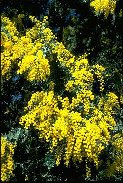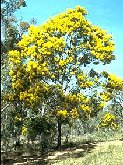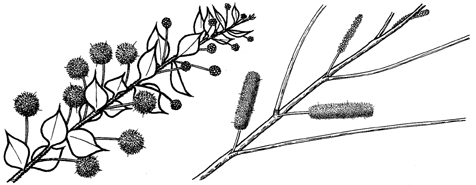Acacia
baileyana Cootamundra Wattle
Description: Small tree or large
shrub to 10 m high by 6 m across. Leaves are grey, bipinnate and leaflets
are linear. Profuse, gold, ball-shaped flowers occur in late winter. Pods
are bluish when young. Two other foliage forms are in cultivation. One
has purplish leaves and has been known as Acacia baileyana var.
purpurea,
the other has yellowish tips.
Distribution: NSW, but naturalized
in other areas.
Propagation: From scarified
seed or boiling water treatment, or cuttings of fancy foliage types.
Cultivation: A very hardy
plant in a sunny situation. Suited to most soils. Flowers sporadically
in Brisbane but profusely in southern areas. Good fast-growing screen plant.
Purple foliage form is useful foliage contrast.
Special horticultural attributes:
Frost hardy (will tolerate frosts to
-7 C )
Recommended for its foliage.
Suitable hedge or screen plant.
|

|
Acacia
binervata Two-veined Hickory
Description: Medium-sized,
dense tree to 16 m high with phyllodes to 12 cm, usually two-veined. Bears
cream ball-shaped flowers in spring.
Distribution: Qld. and NSW.
Propagation: From scarified
seed or boiling water treatment.
Cultivation: A hardy plant
in most well watered situations. Needs full sun or part shade. Dense shade
tree. Flowers are insignificant.
Special horticultural attributes:
Frost hardy (will tolerate frosts to
-7 C )
Suitable hedge or screen plant.
|

|
Acacia
decurrens Early Black Wattle, Green Wattle
Description: Erect, medium-sized
tree to 15 m high with a green trunk and dark green bipinnate leaves. Very
fine leaflets. Bears golden ball-shaped flowers in spring.
Distribution: Qld. and NSW
(naturalized in Vic., Tas. and ACT).
Propagation: From scarified
seed or boiling water treatment.
Cultivation: A hardy tree
in most situations. Very fast-growing but short lived as a result of borer
attack.
Special horticultural attributes:
Frost hardy (will tolerate frosts to
-7 C )
Suitable hedge or screen plant.
|

|
Acacia
falcata Hickory Wattle, Sally
Description: Erect, tree-like
shrub to 4 m with slender trunk and falcate phyllodes to 15 cm. Bears cream
coloured ball-flowers in early winter.
Distribution: NSW, Qld.
Propagation: From scarified
seed or boiling water treatment.
Cultivation: Generally adaptable
in cultivation, responds to sunny, reasonably well drained positions in
most soils. Very hardy. Often seen on cleared land around Sydney. Frequently
used to revegetate road batters.
Special horticultural attributes:
Suitable for areas of low maintenence
(eg. road batters).
Frost hardy (will tolerate frosts to
-7 C )
|

|
Acacia
floribunda Sally Wattle, Gossamer Wattle
Description: Tall, bushy
shrub or small tree to 6 m. Phyllodes linear to narrow elliptical to 10
cm long. Bears cream flowers in rods to 4 cm long in early spring.
Distribution: NSW, Qld.,
Vic.
Propagation: From scarified
seed or boiling water treatment.
Cultivation: Generally adaptable
in cultivation, responds to sunny, reasonably well drained positions in
most soils. Good, fast-growing screen plant, particularly for coast where
adequate moisture is available. A dwarf form which only reaches about 1
m high is available commercially. It forms a dense rounded shrub.
Special horticultural attributes:
Frost hardy (will tolerate frosts to
-7 C )
Suitable hedge or screen plant.
|

|
Acacia
longifolia Sydney Golden Wattle
Description: Large, erect
shrub to 6 m, sometimes more, with light green phyllodes to 15 cm by 2-3
cm. Flowers in golden spikes occur in spring.
Distribution: NSW, Vic.
Propagation: From scarified
seed or boiling water treatment.
Cultivation: Good, hardy,
fast-growing species for screening. Suitable for hydroseeding work on banks.
Has become a weed in South Africa.
Special horticultural attributes:
Suitable for areas of low maintenence
(eg. road batters).
Frost hardy (will tolerate frosts to
-7 C )
Suitable hedge or screen plant.
|

|
Acacia
podalyriifolia Queensland Silver Wattle
Description: Tall shrub or
small tree to 8 m high by 5 m across. Silver-grey phyllodes, obliquely
elliptical, to 4 cm, with felt-like texture. Golden ball-shaped flowers
occur in late winter.
Distribution: Qld.
Propagation: From scarified
seed or boiling water treatment.
Cultivation: A hardy plant
in most welldrained, sunny situations. Flowers well in mild climates. In
Canberra flowers open over several weeks. Very subject to leaf miner in
Sydney but not in Canberra.
Special horticultural attributes:
Frost hardy (will tolerate frosts to
-7 C )
Recommended for its foliage.
May be used as a feature plant.
Suitable for planting in tropical areas.
|

|
Acacia
saligna Golden Wreath Wattle, Orange Wattle
(Previously known as: Acacia
cyanophylla )
Description: Large shrub
or small tree to 10 m, sometimes developing a spreading crown. Phyllodes
to 20 cm long and up to 2 cm wide, occasionally bluish. Flowers are large
golden balls in spring.
Distribution: WA (naturalized
in other States).
Propagation: From scarified
seed or boiling water treatment.
Cultivation: Generally adaptable
in cultivation, responds to sunny, reasonably well drained positions in
most soils. Useful as a tall background plant. Very fast growing, hardy,
and resistant to salt spray. Has become a weed in north-eastern NSW and
South Africa.
Special horticultural attributes:
Frost hardy (will tolerate frosts to
-7 C )
Suitable hedge or screen plant.
Resistant to salt spray.
Suitable for planting in tropical areas.
|

|





